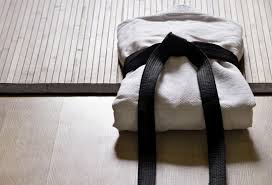Dojo Etiquette
Respect for Oneself and Others

Dojo Etiquette, or Dojo-Kun, is the manner in which each student and teacher expresses discipline and respect when training in the Dojo. We practice etiquette at all times to build character, and integrate as a group to better focus on our training. Etiquette is displayed to the training hall, your teacher, and to each other.
Below are several key forms of etiquette when training:
Dojo
- Training is performed without shoes though socks or tabi socks may be worn. Please leave your shoes at the door upon entering the building.
- Before stepping on to the mat, always bow towards the shomen (front of the room) first, and enter the mat with your left foot first. Bow a second time towards any senior students (Senpai) after stepping onto the mat.
- When leaving the mat, reverse the procedure; bow, then step off backwards, right foot first.
- When carrying a sword outside your obi, it must be held at your side in the right hand. Holding it in your left hand indicates your readiness to draw, a very aggressive posture.
- If necessary to leave the training mat in the middle of a class for restroom or water break, remove your sword and place it at the side or back of the room.
- When laying a sword to the side when not in use, place the sword at the back or side of the room, never in the middle of the training mat, with the tip (kissaki) and edge (ha) facing away from the shomen.
- Students must assist in cleaning the dojo following each practice.
Sensai/Shibucho
- Unnecessary talking during class should be kept to a minimum; class time is limited, and should be used for training-related activities only. If you have questions about a particular technique, ask the instructor or senior student for clarification on the side; do not interrupt class to do so.
- When the instructor or senior student is providing instructions/directions, it is proper respect to kneel in seiza so that only the instructor is standing. This shows respect and allows other students to see the instructor. Verbal responses to the instructors should be simple with a simple Hai (yes). As mentioned before, please keep unnecessary talking to a minimum.
Other
- Always respect your equipment, and that of others.
- Never step over a sword when it is lying on the ground.

